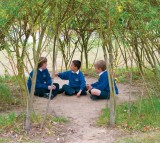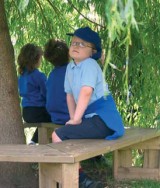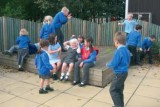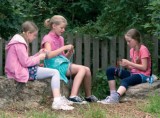The way you use, design and manage your school grounds can change pupils’ behaviour and their attitudes to learning...
A few carefully considered changes to your school grounds can have a big impact on pupils’ behaviour. Generally speaking, there’s not a one size fits all approach as the specific needs of children and staff need to be factored into any alterations, but there are some practical steps that all schools can follow.
Having a variety of different spaces for children to gather, play, learn and explore stops them from getting bored, promotes cooperation and leads to more positive attitudes towards education. As a result, self-esteem and general well-being increases, improving behaviour throughout the school community.
In a survey of schools that changed the use of their grounds with support from Learning through Landscapes, 73% reported that behaviour had improved, 64% saw a reduction in bullying and 84% observed improved social interaction.
Poorly designed grounds will often lead to poor behaviour at break time. With little to do, pupils quickly get bored and fighting and teasing can result. By taking a fresh look at how you use your school grounds you encourage children to make choices about how they play, and reduce both accidents and bullying outside. Consider:
Variety
Children need both intimate and open places, places for noisy and for quiet play, and places for both large and small groups. Behaviour can be improved by providing a wider range of activities through flexible play equipment.
 Relaxation and encouragement
Relaxation and encouragement
Children need to feel safe and supervised but not overlooked; they want to be able to watch activities or choose to take part in them.
Room to move
There should be plenty of space for each and every child so that they can encourage one another in play. If there are a variety of spaces available (soft/hard surfaces, flat/undulating areas, walls/fences), children won’t gather together in one area.
Time
Some of the most beneficial play experiences take time to evolve naturally. Consider structuring the school day differently to provide genuine opportunities to see the full value of improved break times.
So what does this mean in practice? Separating areas doesn’t necessarily entail largewalls or fences between spaces, but it does mean that different activities are less likely to impede on each other. In some schools a simple rule about where activities can take place or a painted line across the playground can be enough. In others, more substantial delineation works better – possibly a low fence or hedge, planters, cones or spaces defined by the use of different materials. Whatever is used, visibility across the site also needs to be considered. Make sure that sight lines are not restricted, allowing bad behaviour to take place out of view.
Many schools are adding multi-use games areas to their grounds but this is not the only way a space can have multiple uses. For example, a space that is used for gathering a class together for lessons outside can be a great space for meeting friends, for eating lunch or a comfortable place for parents to wait at the end of the school day.
But the use of your school grounds shouldn’t just be about play: teaching outside can also have a positive impact on behaviour – particularly in lesson times. The use of a larger outdoor space provides many opportunities for contextual learning and hands-on experiences. Teaching outdoors not only offers opportunities for activities that cannot take place inside, but pupils who are easily distracted by others find they can ‘get away’ from their peers and concentrate on their own work. Whilst some teachers are concerned that pupil behaviour outside will be hard to control, time and time again teachers find the children they were most worried about thrive outside. These pupils become totally absorbed in what they are doing and therefore lessons run more smoothly, and everyone benefits from less disruption.
 At Thongsley Fields Primary School in Cambridgeshire a quiet zone was introduced to provide a space that allowed children to get away from the main play area. “Our grounds play a huge part in how our children play, communicate and socially develop,” says deputy head Rebecca Pentney. “Since we introduced the quiet zone there has definitely been a reduction in conflicts. The children now understand and value the fact that you can choose to be quiet or take some time out to be on your own.” Melissa, aged eight, agrees: “When you go to the quiet zone you can sit down and close your eyes, you can breathe in and out and just stop for a while…It’s also good to see other children there because if they are calm, and you are calm, you can all play in the same way and everyone gets on.”
At Thongsley Fields Primary School in Cambridgeshire a quiet zone was introduced to provide a space that allowed children to get away from the main play area. “Our grounds play a huge part in how our children play, communicate and socially develop,” says deputy head Rebecca Pentney. “Since we introduced the quiet zone there has definitely been a reduction in conflicts. The children now understand and value the fact that you can choose to be quiet or take some time out to be on your own.” Melissa, aged eight, agrees: “When you go to the quiet zone you can sit down and close your eyes, you can breathe in and out and just stop for a while…It’s also good to see other children there because if they are calm, and you are calm, you can all play in the same way and everyone gets on.”
 Mary Caven, headteacher at Prior Weston Primary School in Islington, restructured the school day by removing the mid-morning break in favour of an extended lunchtime. “For three years while the school was being redeveloped, our pupils had to share a small outdoor space that wasn’t very stimulating,” recalls Mary. “We immediately noticed a rise in quarrels and disputes which invariably spilled over into the classroom and disrupted lessons. We knew then that the design of a playground is intrinsic to promoting positive behaviour.”
Mary Caven, headteacher at Prior Weston Primary School in Islington, restructured the school day by removing the mid-morning break in favour of an extended lunchtime. “For three years while the school was being redeveloped, our pupils had to share a small outdoor space that wasn’t very stimulating,” recalls Mary. “We immediately noticed a rise in quarrels and disputes which invariably spilled over into the classroom and disrupted lessons. We knew then that the design of a playground is intrinsic to promoting positive behaviour.”
Having invested time in working with the pupils to create a much more stimulating space for the new school, the staff also recognised that playtime is the most enjoyable part of the day for the children, and that really developed play requires uninterrupted time. “The effect on the children has been astonishing,” says Mary. “Playground disputes have virtually disappeared; everyone – staff and pupils – enjoys their time outdoors. When they come back into the classroom the children settle happily and quickly back into their lessons.”
 The development of the grounds at Carlton Colville Primary School in Lowestoft has created an outdoor space that encompasses the school’s thematic approach to teaching, allowing a broad range of cross-curricular learning all year round. Each term’s theme is introduced outdoors with activities on a larger scale than indoors can allow. Headteacher Carol Child explains, “We’ve had the youngest children practicing phonics by doing a ‘sound hunt’ around the grounds. Y2 pupils focused much of their Knights and Castles topic outside, using our very own Carlton Castle for role play, speaking and listening and a re-enactment of the Battle of Hastings. Our Y3 pupils kept a diary of the pond snails in our wildlife area - monitoring and recording both the weather and the activity of the snails themselves. We’ve also developed one area as a shop, which is used to introduce pupils to handling money - something they do increasingly rarely these days.”
The development of the grounds at Carlton Colville Primary School in Lowestoft has created an outdoor space that encompasses the school’s thematic approach to teaching, allowing a broad range of cross-curricular learning all year round. Each term’s theme is introduced outdoors with activities on a larger scale than indoors can allow. Headteacher Carol Child explains, “We’ve had the youngest children practicing phonics by doing a ‘sound hunt’ around the grounds. Y2 pupils focused much of their Knights and Castles topic outside, using our very own Carlton Castle for role play, speaking and listening and a re-enactment of the Battle of Hastings. Our Y3 pupils kept a diary of the pond snails in our wildlife area - monitoring and recording both the weather and the activity of the snails themselves. We’ve also developed one area as a shop, which is used to introduce pupils to handling money - something they do increasingly rarely these days.”
Learning through Landscapes (LTL) is a UK charity dedicated to enhancing outdoor learning and play for children. It aims to help children connect with nature, be more active and engaged with their learning, develop social skills and have fun. Visit ltl.org.uk or call 01962 845811 for more information.
Behaviour management: choosing the right words
Behaviour Management
